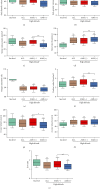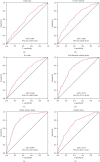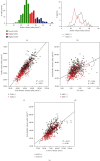Low Stroke Volume Index in Healthy Young Men Is Associated with the Incidence of Acute Mountain Sickness after an Ascent by Airplane: A Case-Control Study
- PMID: 33224980
- PMCID: PMC7673943
- DOI: 10.1155/2020/6028747
Low Stroke Volume Index in Healthy Young Men Is Associated with the Incidence of Acute Mountain Sickness after an Ascent by Airplane: A Case-Control Study
Abstract
Background: The aims of this study were to explore the characteristics of left ventricular (LV) functional changes in subjects with or without acute mountain sickness (AMS) and their associations with AMS incidence.
Methods: A total of 589 healthy men were enrolled and took a trip from Chengdu (500 m, above sea level (asl)) to Lhasa (3700 m, asl) by airplane. Basic characteristics, physiological data, and echocardiographic parameters were collected both at Chengdu and Lhasa, respectively. AMS was identified by the Lake Louise Questionnaire Score.
Results: The oxygen saturation (SpO2), end-systolic volume index, end-diastolic volume index (EDVi), stroke volume index (SVi), E-wave velocity, and E/A ratio were decreased, whereas the heart rate (HR), ejection fraction, cardiac index (CI), and A-wave velocity were increased at the third day after arrival, as evaluated by an oximeter and echocardiography. However, AMS patients showed higher HR and lower EDVi, SVi, CI, E-wave velocity, and E/A ratio than AMS-free subjects. Among them, SVi, which is mainly correlated with the changes of EDVi and altered LV filling pattern, was the most valuable factor associated with AMS incidence following receiver-operator characteristic curves and linear and Poisson regression. Compared with subjects in the highest SVi tertile, subjects in the middle SVi tertile showed higher multivariable Incidence Rate Ratios (IRR) for AMS with higher incidences of mild headache and gastrointestinal symptoms, whereas subjects in the lowest SVi tertile showed even higher multivariable IRR with higher incidences of all the symptoms.
Conclusions: This relatively large-scale case-control study revealed that the reduction of SVi correlated with the altered LV filling pattern was associated with the incidence and clinical severity of AMS.
Copyright © 2020 Jingbin Ke et al.
Conflict of interest statement
The authors declare that they have no conflicts of interest.
Figures




Similar articles
-
[The change of left ventricular function upon acute high altitude exposure and its relationship with acute mountain sickness].Zhongguo Ying Yong Sheng Li Xue Za Zhi. 2014 May;30(3):223-6. Zhongguo Ying Yong Sheng Li Xue Za Zhi. 2014. PMID: 25244786 Chinese.
-
Acute mountain sickness, arterial oxygen saturation and heart rate among Tibetan students who reascend to Lhasa after 7 years at low altitude: a prospective cohort study.BMJ Open. 2017 Jul 10;7(7):e016460. doi: 10.1136/bmjopen-2017-016460. BMJ Open. 2017. PMID: 28698346 Free PMC article.
-
[Changes in oxygen saturation can not help diagnose acute mountain sickness (AMS): ascending to Lhasa on the Qinghai-Tibet train].Zhongguo Ying Yong Sheng Li Xue Za Zhi. 2016 Jun 8;32(6):519-524. doi: 10.13459/j.cnki.cjap.2016.06.008. Zhongguo Ying Yong Sheng Li Xue Za Zhi. 2016. PMID: 29926619 Chinese.
-
Rate of ascent and acute mountain sickness at high altitude.Clin J Sport Med. 2015 Mar;25(2):95-104. doi: 10.1097/JSM.0000000000000098. Clin J Sport Med. 2015. PMID: 24751723
-
Changes in metabolic and hematologic laboratory values with ascent to altitude and the development of acute mountain sickness in Nepalese pilgrims.Wilderness Environ Med. 2006 Fall;17(3):171-7. doi: 10.1580/pr43-04. Wilderness Environ Med. 2006. PMID: 17078312
Cited by
-
Blood Pressure Load: An Effective Indicator of Systemic Circulation Status in Individuals With Acute Altitude Sickness.Front Cardiovasc Med. 2022 Jan 3;8:765422. doi: 10.3389/fcvm.2021.765422. eCollection 2021. Front Cardiovasc Med. 2022. PMID: 35047574 Free PMC article.
-
The Impact of Temporary Stay at High Altitude on the Circulatory System.J Clin Med. 2021 Apr 12;10(8):1622. doi: 10.3390/jcm10081622. J Clin Med. 2021. PMID: 33921196 Free PMC article. Review.
-
Cardiovascular Indicators of Systemic Circulation and Acute Mountain Sickness: An Observational Cohort Study.Front Physiol. 2021 Aug 27;12:708862. doi: 10.3389/fphys.2021.708862. eCollection 2021. Front Physiol. 2021. PMID: 34512383 Free PMC article.
References
MeSH terms
LinkOut - more resources
Full Text Sources

